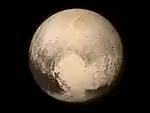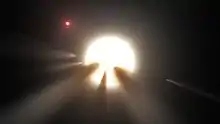K2-3
K2-3, also known as EPIC 201367065,[4] is a red dwarf with three known planets. All are Super-Earths, and the outermost is in the habitable zone.[8] It is on the borderline of being a late orange dwarf/K-type star, but because of its temperature, it is classified as a red dwarf (4,000 K is typically the division line between spectral class M and K).
| Observation data Epoch J2000 Equinox J2000 | |
|---|---|
| Constellation | Leo[1] |
| Right ascension | 11h 29m 20.3918s[2] |
| Declination | −01° 27′ 17.280″[2] |
| Apparent magnitude (V) | 12.168±0.009[3] |
| Characteristics | |
| Spectral type | M0V[4] |
| B−V color index | 1.35 ± 0.06[4] |
| Astrometry | |
| Radial velocity (Rv) | 32.6±1[5] km/s |
| Proper motion (μ) | RA: 94.034±0.094[2] mas/yr Dec.: −78.139±0.057[2] mas/yr |
| Parallax (π) | 22.6610 ± 0.0553[2] mas |
| Distance | 143.9 ± 0.4 ly (44.1 ± 0.1 pc) |
| Details | |
| Mass | 0.601 ± 0.089[4] M☉ |
| Radius | 0.561 ± 0.068[4] R☉ |
| Temperature | 3835±70[6] K |
| Metallicity [Fe/H] | −0.01±0.09[6] dex |
| Rotation | 40±2 d[7] |
| Age | ≥1[5] Gyr |
| Other designations | |
| Database references | |
| SIMBAD | data |
At a distance of about 144 light-years,[2] the star ranks among the top 10 nearest stars known to have transiting planets. The star's proximity means it is bright enough to make it feasible for astronomers to study the planets' atmospheres to determine whether they are like Earth's atmosphere and possibly conducive to life.
Planetary system
K2-3 has at least three confirmed exoplanets:[5]
| Companion (in order from star) |
Mass | Semimajor axis (AU) |
Orbital period (days) |
Eccentricity | Inclination | Radius |
|---|---|---|---|---|---|---|
| b | 6.6±1.1 M⊕ | 0.0777+0.0024 −0.0026 |
10.05454±0.00003 | 0.06 ± 0.06 | 89.59+0.24 −0.40° |
2.29±0.23 R⊕ |
| c | 3.1+1.3 −1.2 M⊕ |
0.1413+0.0044 −0.0047 |
24.64638±0.00017 | 0.04 ± 0.04 | 89.70 ± 0.20° | 1.77±0.18 R⊕ |
| d | 2.7+1.2 −0.8 M⊕ |
0.2097+0.0065 −0.0070 |
44.55764±0.00042 | 0.045 ± 0.045 | 89.79 ± 0.15° | 1.65±0.17 R⊕ |
References
- Roman, Nancy G. (1987). "Identification of a Constellation From a Position". Publications of the Astronomical Society of the Pacific. 99 (617): 695–699. Bibcode:1987PASP...99..695R. doi:10.1086/132034. Vizier query form
- Brown, A. G. A.; et al. (Gaia collaboration) (August 2018). "Gaia Data Release 2: Summary of the contents and survey properties". Astronomy & Astrophysics. 616. A1. arXiv:1804.09365. Bibcode:2018A&A...616A...1G. doi:10.1051/0004-6361/201833051. Gaia DR2 record for this source at VizieR.
- Henden, A. A.; et al. (2016). "VizieR Online Data Catalog: AAVSO Photometric All Sky Survey (APASS) DR9 (Henden+, 2016)". VizieR On-line Data Catalog: II/336. Originally Published in: 2015AAS...22533616H. 2336. Bibcode:2016yCat.2336....0H.Vizier catalog entry
- "K2-3 PLANET HOST OVERVIEW PAGE". NASA Exoplanet Archive. Retrieved 2015-10-17.
- Crossfield, Ian J. M.; et al. (2015). "A Nearby M Star with Three Transiting Super-Earths Discovered by K2". The Astrophysical Journal. 804 (1). 10. arXiv:1501.03798. Bibcode:2015ApJ...804...10C. doi:10.1088/0004-637X/804/1/10.
- Damasso, M.; et al. (2018). "Eyes on K2-3: A system of three likely sub-Neptunes characterized with HARPS-N and HARPS". Astronomy and Astrophysics. 615. A69. arXiv:1802.08320. Bibcode:2018A&A...615A..69D. doi:10.1051/0004-6361/201732459. S2CID 58923147.
- Kosiarek, Molly R.; et al. (2019). "Bright Opportunities for Atmospheric Characterization of Small Planets: Masses and Radii of K2-3 b, c, and d and GJ3470 b from Radial Velocity Measurements and Spitzer Transits". The Astronomical Journal. 157 (3). 97. arXiv:1812.08241. Bibcode:2019AJ....157...97K. doi:10.3847/1538-3881/aaf79c.
- Three Super-Earths Found Circling Nearby Red Dwarf
This article is issued from Wikipedia. The text is licensed under Creative Commons - Attribution - Sharealike. Additional terms may apply for the media files.



